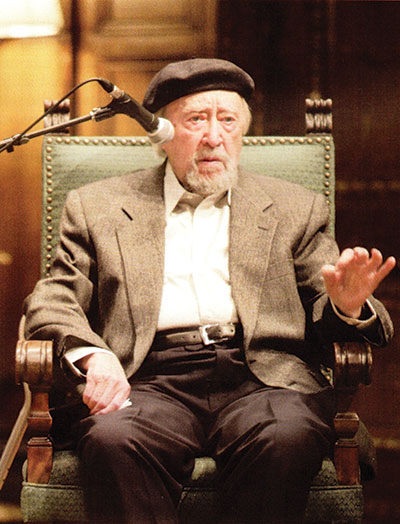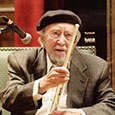 After an absence of 30 years, legendary flutist and teacher Joseph Mariano returned to the Eastman School of Music in Rochester, New York on November 15, 2003, where he had taught for almost 40 years. Many of his former students attended this extraordinary homecoming and paid tribute to the man who had helped them to become distinguished flutists. Four current students at the school participated in a masterclass with him. At the unveiling of his portrait in the Cominsky Promenade, an amazing flute choir performed a work written and conducted by Katherine Hoover. Most in the flute choir were former students of Mariano, and the group of about 35 included Walfrid Kujala, Philip Swanson, Leone Buyse, Patricia George, Gerald Carey, Glennis Stout, and Susan Levitin. After a buffet dinner, Mariano and clarinetist Stanley Hasty, hornist Morris Secon, and bassoonist David VanHoesen, all former Eastman colleagues, discussed the evolution of wind playing from the mid-20th century to the present. The evening concluded with a gala concert by the Eastman Philharmonia Chamber Orchestra conducted by Neil Varon and concerto competition winner, Hilary Abigana, who performed Carl Nielsen’s Concerto for Flute.
After an absence of 30 years, legendary flutist and teacher Joseph Mariano returned to the Eastman School of Music in Rochester, New York on November 15, 2003, where he had taught for almost 40 years. Many of his former students attended this extraordinary homecoming and paid tribute to the man who had helped them to become distinguished flutists. Four current students at the school participated in a masterclass with him. At the unveiling of his portrait in the Cominsky Promenade, an amazing flute choir performed a work written and conducted by Katherine Hoover. Most in the flute choir were former students of Mariano, and the group of about 35 included Walfrid Kujala, Philip Swanson, Leone Buyse, Patricia George, Gerald Carey, Glennis Stout, and Susan Levitin. After a buffet dinner, Mariano and clarinetist Stanley Hasty, hornist Morris Secon, and bassoonist David VanHoesen, all former Eastman colleagues, discussed the evolution of wind playing from the mid-20th century to the present. The evening concluded with a gala concert by the Eastman Philharmonia Chamber Orchestra conducted by Neil Varon and concerto competition winner, Hilary Abigana, who performed Carl Nielsen’s Concerto for Flute.
Mariano was born in Pittsburgh on March 17, 1911 and began flute lessons on an instrument that his father had received in payment for a favor. Later Mariano studied with William Kincaid and Marcel Tabuteau at the Curtis Institute of Music and played in the National Symphony Orchestra for one year. He left in 1935 to become the flute professor at Eastman, and six years later he became principal flute of the Rochester Philharmonic Orchestra while continuing to teach at Eastman. Although courted by Fritz Reiner and Arturo Toscanini for positions in the Chicago and N.B.C. symphonies, Mariano remained in Rochester until his wife became ill. He requested a leave of absence for one year, but Eastman offered him just one semester of leave. Mariano was so upset that within a week he had sold his house. He moved to Massachusetts and for the next 29 years never even visited the campus until last November.
Sporting a black beret, gray goatee, and mustache, the dapper, 92-year-old walked on stage at Kilbourn Hall using a cane to a standing ovation from the audience of alumni and present Eastman students. He was obviously moved at the tribute, and after gathering his emotions, thanked the crowd saying, "It’s a distinct pleasure, I am sure. This is the place where I grew up musically." Bonita Boyd, who studied with Mariano and now teaches at Eastman, talked with this grand old gentleman for the next 45 minutes. His responses were articulate, heart-felt, and punctuated by the subtle humor for which he is known. The following excerpts from their conversation capture some of the flavor and emotion of the occasion.
What are the qualities that make an artist?
Dig deep inside to be the best you can be. Study all the parts that make an artist, the melody, the architecture, the painting, and do it in depth. That’s the secret to being an artist – dedication every day until you die.
When I asked that question on the telephone, you mentioned practice.
Practice makes perfect. It is not perfection just to do things you need to do to express a piece of music, which was written by an artist. You have to dedicate yourself to the same standards as artists like Bach, Brahms, or Beethoven, which is a tall order.
On the phone you said something about six hours a day.
Practice comes first. Players should practice as many hours as they can in a day. Eight or nine hours would be normal, but to be an artist they should pay attention up here (pointing to his head). Marcel Tabuteau, one of my teachers and probably the greatest oboe player who ever lived, said, "Play mentally." I think like that.
What kind of training did you receive from William Kincaid and Tabuteau?
It was like no training you would ever get from anyone other than a Tabuteau. When he turned a phrase, it was like God gave it to him. Kincaid was a bit different, more modern, and less rigid in his attitude with pupils. My first year in Curtis the newcomers had three-hour-long classes in the basement with Tabuteau, who lined us up like Indians to play scales. Look out if you played out of tune; you would receive a big lesson on what to do about pitch.
Kincaid was different and assigned etudes, Bach, and Berbiguier, often only touching on the etudes and skipping the last half of one to move on to another. I gained my love of Bach’s music from Kincaid, who emphasized Bach. I even warmed-up with Bach sonatas, never scales. After all, there are scales in Bach. There you have it in a nutshell.
I guess it would be easy to guess who your favorite composer is.
Bach. Brahms, yes, Beethoven, yes, but Bach is the foundation of music. I own records of Bach by the great performers of our time and play them every day. I never tire of them, especially if the performers are great. Have that name emblazoned on your heart and on your mind. I think all students, no matter what instrument they play, should play Bach every day – even before scales.
How do you describe the process of creating a great flute sound?
Sound is very easy if you hear it. If a player can sing it, they should be able to play it. Flutists hardly ever practice pp because they become so enamored of their ff. I remember asking a very talented Eastman student to start a sound from nothing, crescendo up to a point, and diminuendo down to nothing. It took months for him to learn to start a sound from nothing. It’s easy if you practice.
When we talked earlier you mentioned that flutists should practice six hours a day, seven days a week. How you would spend those six hours?
Players should adopt practice policies that suit them. You stop practicing for one day, and you know it. Stop practicing for two days, and your friends know it, but if you don’t practice for three days, everybody knows it.
What lead you into a lifetime of music, and where did your musical passion come from?
My mother was a frustrated singer, and she got married too soon to develop her song. She sang in Italian all the time and even sang along with me when I practiced arpeggios. She sang in tune with a nice, untutored voice. I loved my mother, and think I got my love for music from her … although I had uncles, who played instruments also.
[When the audience could ask questions, a former student asked Mariano to describe the essence, a term he frequently used in flute lessons.]
That’s a tough question. I think one feels the essence, but I can’t describe it. It is something that you are born with. Ask DiVinci what the essence was of the works he painted in Italy. God, the ages, something eternal, magical. It is tough to describe that one.
I think we all remember lessons when the essence was missing.
I remember those days. Play the Syrinx. You all know the Syrinx? If you don’t you should learn it (laugher). Syrinx is a beautiful piece of music. Debussy must have been in seventh heaven when he wrote it. I played it often. It’s one of my favorite pieces, along with the slow movements of the Bach sonatas. Not the fast movements, but the slow ones. You have to work up to the fast ones after playing for two or three hours. You could give up playing the flute or anything, but never give up the slow movements by Bach.
I remember when you assigned Syrinx for the next lesson and asked me to play it ten different ways. After I got through the first six or seven you said, "That’s enough."
Syrinx is hard enough to play the real way but to transpose it is another job. It is almost impossible to transpose it up a half a step. I’ve tried it and had to write it down. The effort was what counted.
[Mariano also spoke about conductors and orchestras.]
Jose Iturbi was a "great pianist and dear friend of mine, who conducted our orchestra for many years. He always crossed himself before he came out on the stage and said a little prayer prior to that. When soloing with the orchestra, he took a moment at the piano before he played, maybe 20-30 seconds, and the same thing happened when he conducted the orchestra. Iturbi used a baton and was not a gentle conductor. There were other conductors with a more legato, sedate beat and who were more reflective than he was. All conductors are crazy.
I loved and unloved most conductors; some were not nice people. When I played Afternoon of a Faun, there was always a battle between me and the conductors, and I wondered whether they would start it properly. Some defied me to play that opening C# well, and others helped. I always said a little something under my breath to those who defied me. That C# entrance should be as beautiful as it can be and set the entire tone of the piece. It is one of my very favorite pieces of music.
We had a foreign conductor who gave me a speech about Faun. I can’t remember his name, and probably have forgotten him because he told me the whole Greek myth and how to play every note. Finally I said, ‘If you want to play it, come along and you play it. You have a lot of nerve telling me how to play that solo. You try it. Sing it, if you can’t play it.’
Most conductors are not like that. The whole orchestra makes that marvelous sound, like a warm summer day. An orchestra is an orchestra of many people, not just the flute or an oboe player. That’s why you have the Philadelphia Orchestra, because they are all very fine players, down to the last violin player at the second stand. The Boston Symphony too. Orchestras are slowly beginning to rise to this level of performance all over the country, because the big ones, such as the New York Philharmonic, and Philadelphia, and Boston have set the tone, the standard.
There were stick wavers and conductors. When Pierre Monteux came to play with our orchestra for the first time, we could hardly see the baton because he was a short little man with a very small baton. He scheduled a French program, Daphnis, Faun and some other things, and was one of the most beautiful concerts we ever played. We had a minimum of trouble. He just conducted his part, a well-trimmed beat, and didn’t wave like some conductors do, who get all excited over nothing, I treasure the memory of that concert.
Toscanini never conducted in Rochester, fortunately. He was neither here or there, and he was frightened of death. His ffs were too loud, and there were no pps. I believe in pps, which set the tone for the range of the sound.
[During a short masterclass with four students he urged them to keep going and never stop.]
These students are all on the right track and very musical. The trick is to keep on track musically to integrate the whole thing. Vibrato is sin. It should never have been invented. Vibrato should be incorporated into the sound itself. So many pulses, according to the individual. We all have a different sense of what vibrato should be. These talented students are in the right place and studying with this young lady here, Bonita Boyd. Tone and vibrato all came naturally to me. I had nothing to do with it.
(Boyd) Some days you said, "You’re a good flute player; now be an artist."
That sounds about right. Phrasing and musicianship are lost today. Everybody plays technically as if they were crazy. Tabuteau was a fiend for the right sound and phrasing, which were his forte. He played superbly, like a song, even in fast passages. He did not emphasize technique and believed that as long as players moved their fingers, technique would develop. Musicianship, on the other hand, never comes easily. There should be a song in your heart and soul; it sounds like baloney, but it isn’t.
It has been a joy to be here, and you have been a very receptive audience. I think you [the four students] are all well-trained. Stay that way. God bless you.
.jpg)






